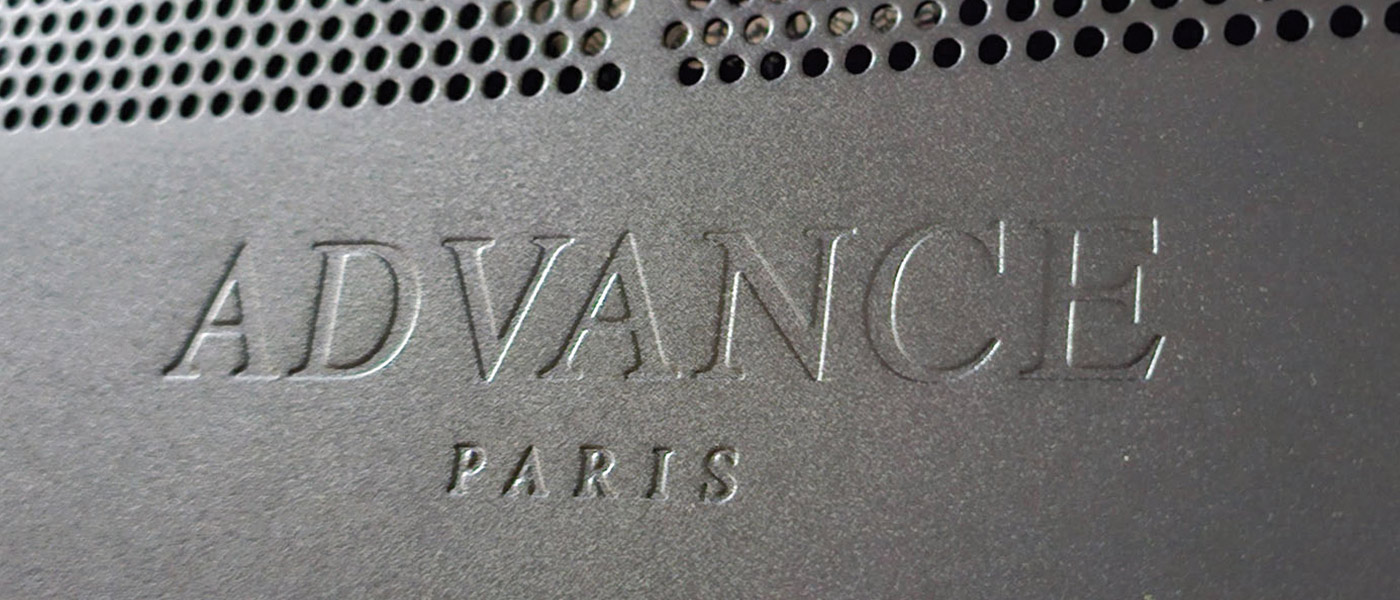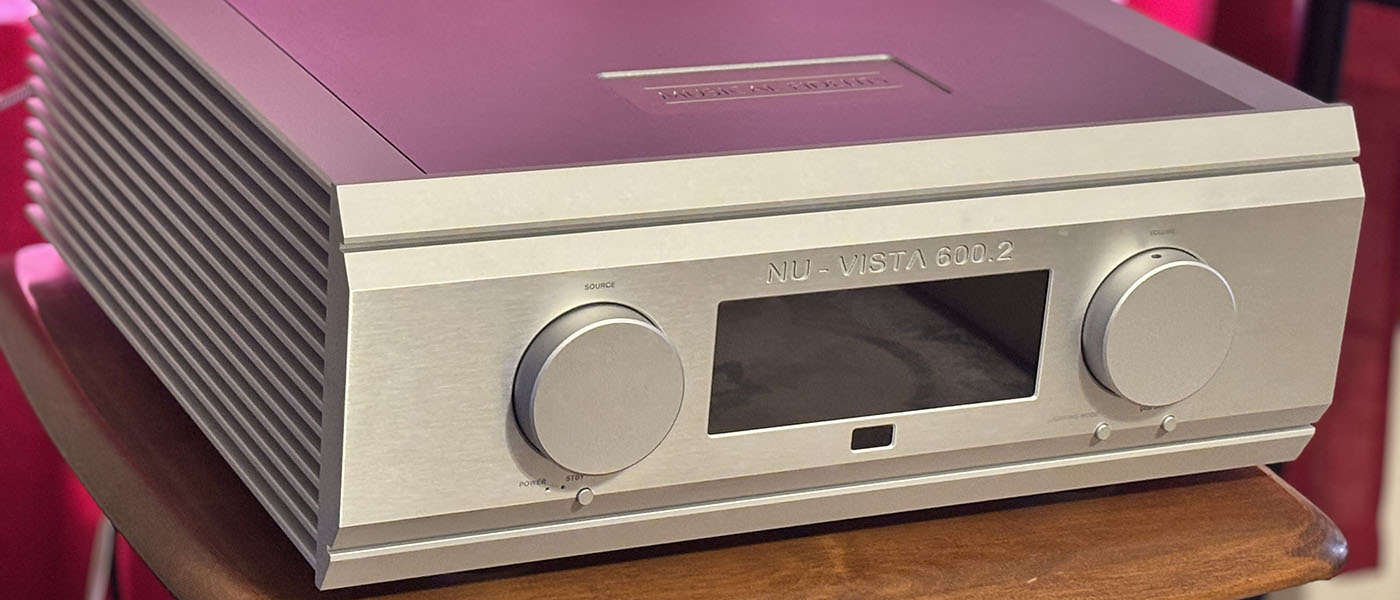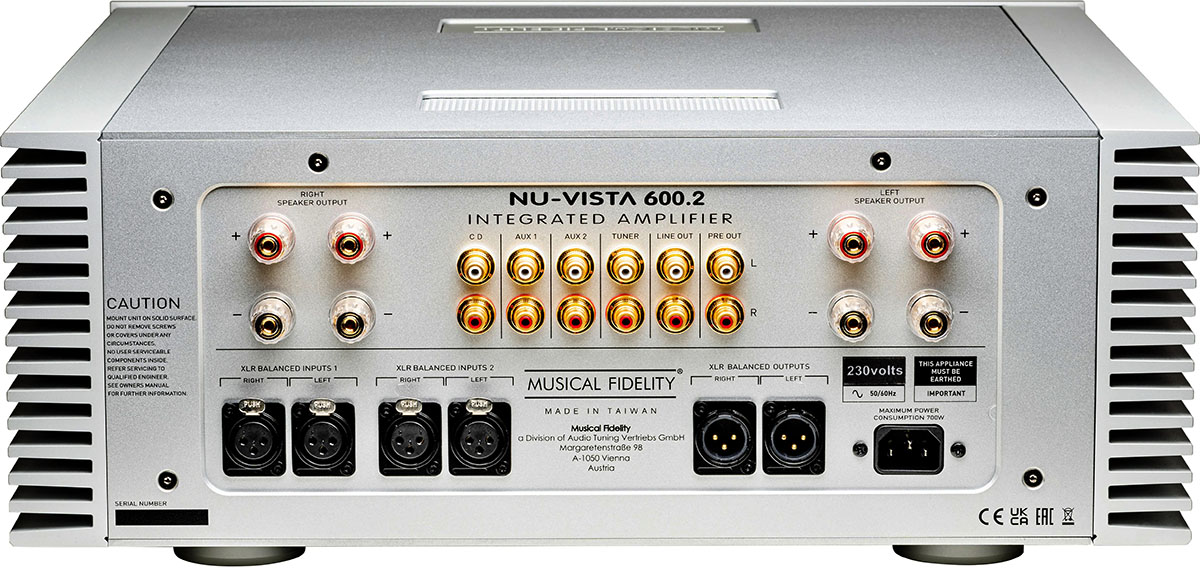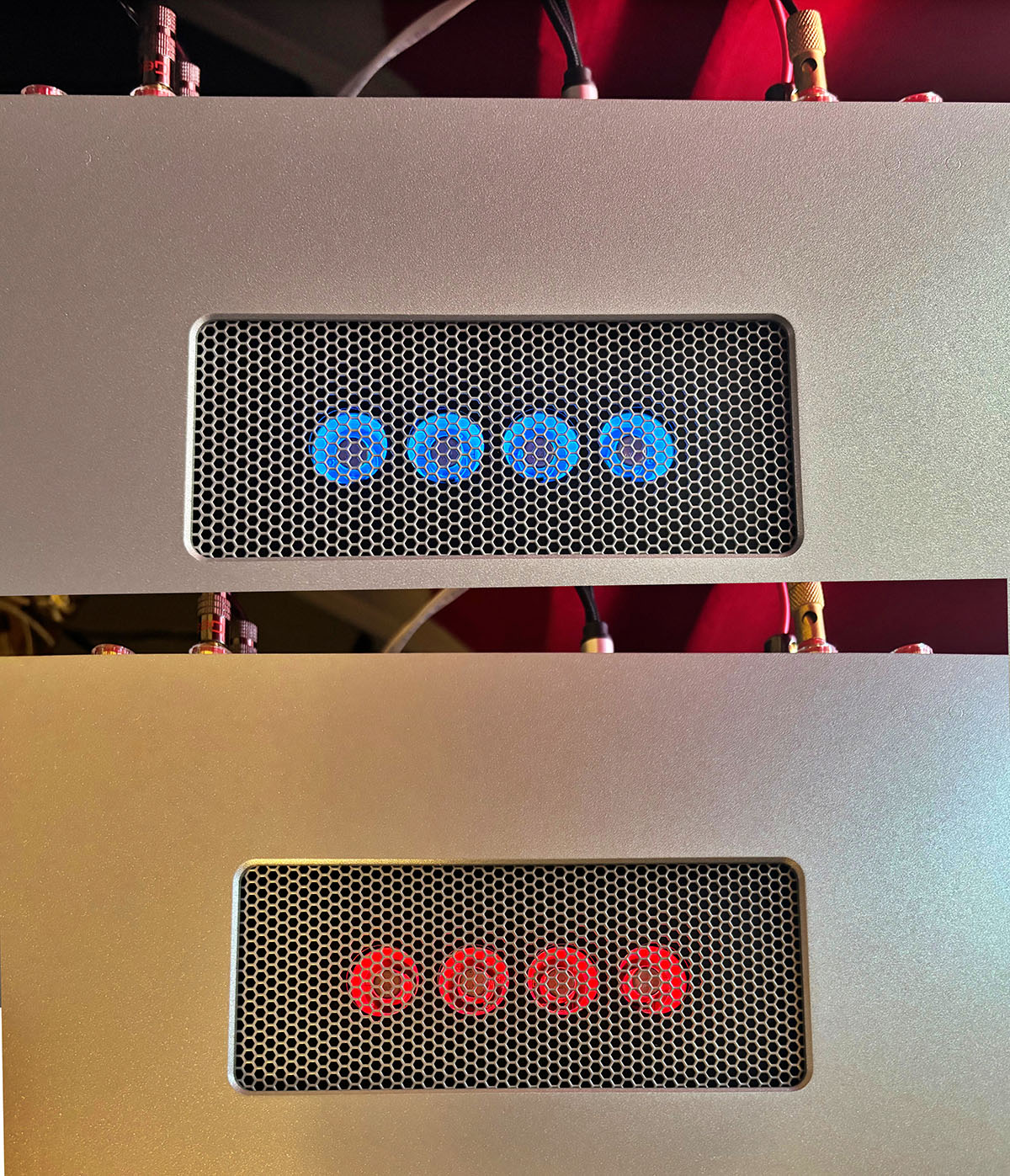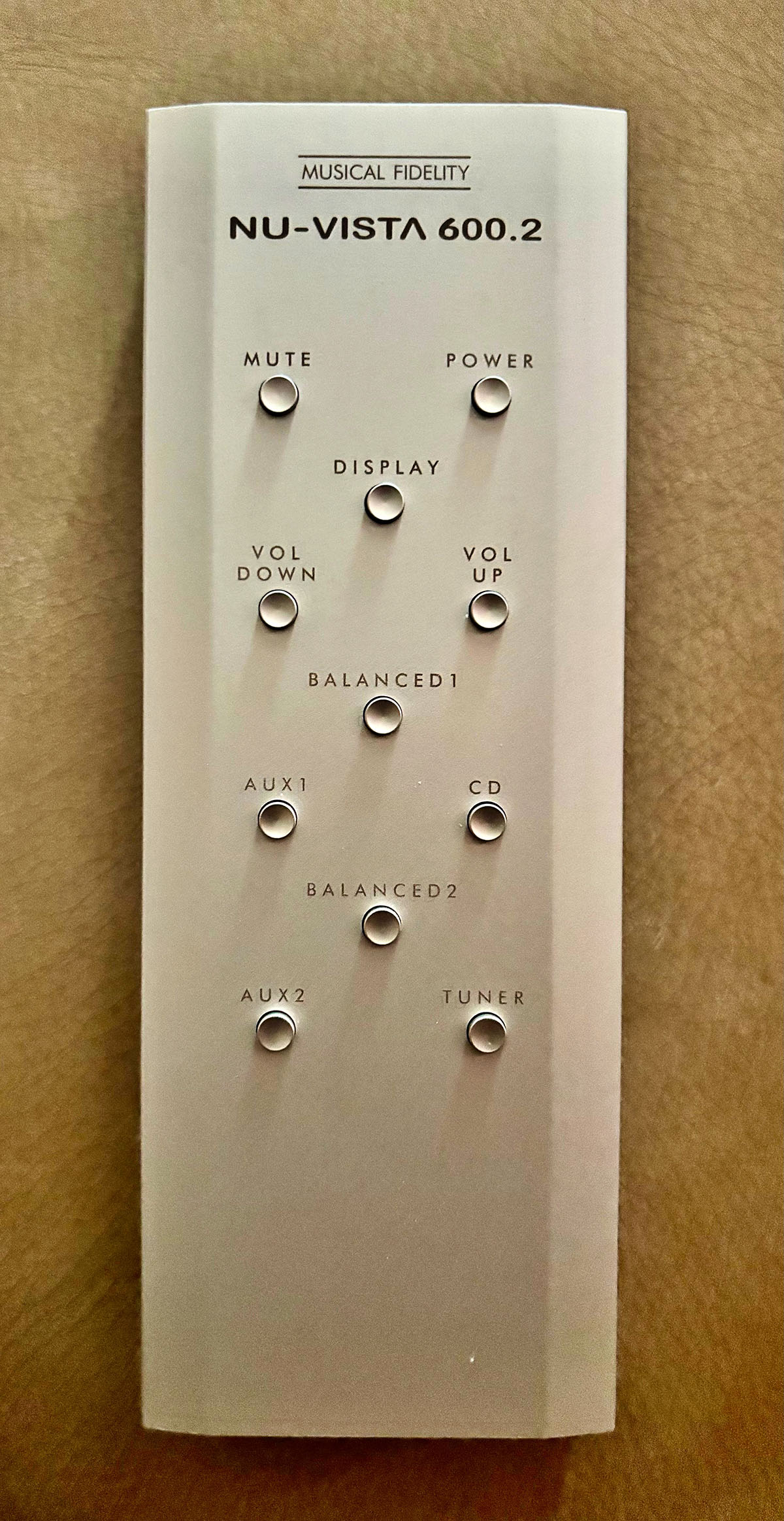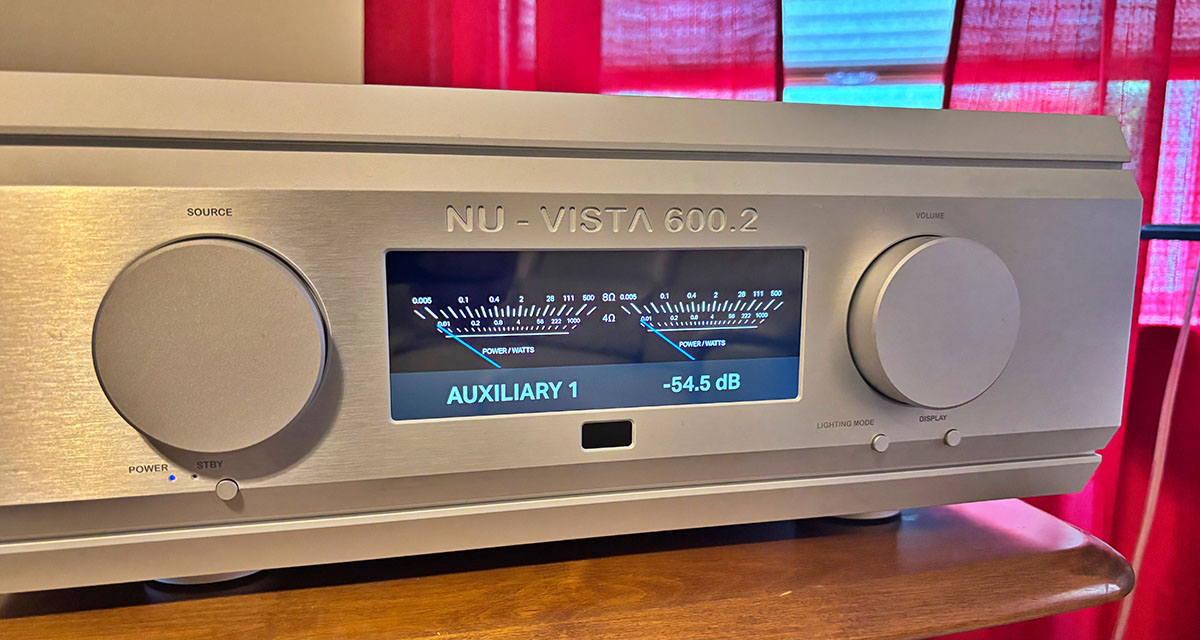Musical Fidelity Nu-Vista 600.2 Integrated Amplifier
- Features the full TITAN power amp design with decoupled output stage
- 160 watts/8 ohms, 300 watts/4 ohms
- Pre-amp uses four 6S51N nuvistor tubes in a Class A discrete buffer
- Laser trimmed volume control with 0.5dB+/- gain error even at low levels
- Fully dual mono design with separate L/R power supplies
- The case acts as a Faraday cage with internal/external electromagnetic field protection
- Analog inputs only
- Impeccable sound quality and extraordinary imaging
Musical Fidelity is a British manufacturer of high-end audio equipment with a reputation for excellence earned from its core product range of amplifiers. Founded in 1982, they now make many different audio products ranging from amplifiers and streamers to CD players and DACs. Their high-end gear has a modern industrial look that makes their products look somewhat distinctive. The Nu-Vista series was introduced in 1997 and incorporates unique nuvistor metal-ceramic vacuum tubes that were developed in the late 1950s. These tubes are smaller than typical glass tubes and are prized for their stability and sonic purity. The most powerful integrated amplifier currently in the line is the Nu-Vista 800.2 integrated. The Nu-Vista 600.2 is the newer, slightly pared-down sibling that is, in reality, a bigger rework and update of its older brother. The chassis and dimensions are about the same, with the 600.2 having slightly less power output and a few pounds shaved off. Even so, it can deliver 140 watts into 8 ohms and weighs a mere 80 pounds. After spending some time with it, I have had a paradigm shift in my thinking. I have always said to people, “If you want a big change in your system’s sound quality, spend half to three-quarters of your budget on speakers!” It is still fair advice, but the Nu-Vista 600.2 has me rethinking that advice, and I will explain later why I have changed my mind.
Class A nuvistor tube stageDual mono preamp circuits and inputsLaser trimmed volume control with +/- 0.5db gain error
Dual mono toroidal power supplies
Bulk capacitance and rectifiers on separate PCB
160 watts in 8 ohms, 300 watts into 4 ohms
Power amp bulk supply capacitance and local output device decoupling is separate
Current:
50 amps peak to peak
Damping Factor:
100
Output devices:
2 pairs/channel
THD+N:
<0.005%, 20 Hz to 20 kHz
SNR:
> 107dB “A” weighted
Frequency response:
+0, -0.1dB, 10 Hz to 30 kHz
Speaker outputs:
2 pairs 4mm banana plug/binding posts
Line level inputs:
two balanced XLR inputs, four RCA inputs
Line level outputs:
one RCA line out (fixed) and one RCA pre-out, one balanced XLR pre-out
Four output transistors per channel
Front and side panels are milled from extruded aluminum
Dimmable display
Milled aluminum remote control
Weight:
79.37 lbs.
Dimensions:
(W) 19 inches, (H) 7.4 inches, (D) 20 inches
MSRP:
$9,999
Website:
US Distributor:
Company:
SECRETS Tags:
musical fidelity, focal naim America, nu-vista 600.2, integrated amplifier, stereo amplifier
- NAD Masters M66 BluOS Streaming DAC-Preamplifier Review
- MOON 681 Network Player/DAC and MOON 641 Integrated Amplifier Review
Secrets Sponsor
Though based on the larger Nu-Vista 800.2, the Nu-Vista 600.2 has been redesigned to use its internal spaces more efficiently. Musical Fidelity has stated that they believe only a purely analog device can achieve the best possible sound quality, and the Nu-Vista 600.2 does just that.
The unit has a slightly retro-industrial look that looks beautiful and projects an air of power simultaneously. With the fluted heat sinks on the side, large symmetrically placed milled aluminum input selector & volume knobs, and a fluorescent VU meter display, the Nu-Vista 600.2 has the look and feel of a real statement piece. Weighing in at almost 80 pounds, it is the heaviest integrated amplifier I’ve had in my home.
On the back, there are two balanced XLRs and four RCAs (for tuner, CD, and two aux). Also, there are two line-outs, one fixed and the other variable. The dual set binding posts are of high quality. I asked about the lack of a built-in phono-stage, and this was addressed by Heinz Lichtenegger:
“In our listening tests, due to the huge magnetic radiation which occurs in such huge amplifiers, we never came to the result that a built-in phono-stage works best. It’s simply not ultimate high-end. In other words, an external phono-stage always sounds better, and we recommend also with the M series amp to sooner or later go for an external phono-stage.”
The Nu-Vista 600.2’s “special sauce” is the four nuvistor tubes that are known for their reliability, immunity to vibration, and longevity. They are smaller than traditional glass vacuum tubes and are made of ceramic and metal. When the unit is powered on, LED lights around the tubes turn red, orange, and blue when they reach optimal operating temperature after about 15 minutes. (I enjoyed music all through the warm-up phase without any notable audio degradation).
In limiting the power output by 30% compared to its bigger brother, the developers were able to shave off 11 pounds of weight compared to the Nu-Vista 800.2. This integrated amp is entirely analog and has a dual mono architecture with a multi-array power supply and a Class A tube stage. The 160 watts into 8 ohms is likely more than enough to make most speakers sing. While playing music through my GoldenEar T66s, I never got the VU meters to jump more than 1/3 of what the full power output could achieve.
Paired with high current capacitors, it has four output transistors/channel. Remember, this is designed as an all-analog device, so there’s no DAC, built-in streamer, Wi-Fi, room correction, or tone controls. The purer the analog in, the better the analog out. I live in an almost exclusively digital world, but I found the Nu-Vista 600.2 a joy to use.
The remote is all aluminum, is a direct line IR type, and has all the function buttons that can be manually accessed from the front panel. It is not backlit, but my finger memory adjusted to it quickly. It is weighty in the hand, and the construction is befitting of a unit of this quality. The display panel is black and white with a blue needle which can be inverted or changed to read in large print the selector input and volume.
Volume is displayed in dB (relative) and not absolute (1-100). It also defaults to -42dB upon startup. This prevents any excessive blasts to your speakers because the knob was accidentally turned way up as you powered on the unit. Safety first, everyone! The display is dimmable as well and can be controlled from the front panel or the remote.
The outer casing is thick, milled aluminum with pleasing lines and symmetry. The small vent on top allows you to see the nuvistor tubes. Product logos are milled into the metal surface, which gives the unit a retro-futuristic look, like some 50s Sci-Fi flick. No silk screening here. Once I placed the unit onto my display table (with my wife’s assistance), I was ready to hook it up and take it for a test drive. I used AudioQuest Rocket 33 speaker cables and a set of balanced interconnects from my Onkyo RZ-TX70 AV Receiver. Streaming was done via the WiiM Ultra streaming box (Qobuz hi-res), and CD/SACD playback was performed through my Oppo UDP-203 disc player. Setup took less than 15 minutes, and I was good to go. At that moment, I was unaware of the impending paradigm shift…
I had recently purchased an A/B speaker selector switch of high quality, which allowed me to A/B compare the Onkyo TX-RZ70 and Nu-Vista 600.2. The Onkyo is no slouch in audio quality, but the Nu- Vista threw a bigger, deeper, and wider soundstage. Details were better resolved. Bass was more solid and punchy. Everything coming out of the T66s sounded more balanced tonally. Even playing at higher volume than normal (for me, anyway), the Nu-Vista 600.2 brought more solidity and presence to the music. After the first week, I realized that I could not “unhear” the difference. I have listened to McIntosh products and an integrated tube amp from Fezz Audio in the last year, but the Nu-Vista did not reflect the “warm tube sound” that the others injected into the music. The Musical Fidelity was powerful, but neutral in sound quality from top to bottom. I recommend pairing the Nu-Vista 600.2 with quality full- range speakers as opposed to smaller bookshelf speakers, though with a sub added into the mix, it may work.
After hours of listening, the unit never got more than mildly warm around the heat sinks. It never broke a sweat. The more time I had with the Nu-Vista 600.2, the more I fell in love with the sound quality. Here are some impressions I had during my time with this integrated.

Yello- Blue Biscuit from the album TOY- This duo has been putting out dance music for many years, and they use sequencers and other things that give their sound deep throbbing bass and avant-garde sound effects that ping around the room in 3D. The Musical Fidelity was made for this stuff. Left/right, front/back soundscapes were massive. I actually got up and put my ear to one of my surround speakers, thinking I must have made a setup error somehow. Nope. It was an example of the amazing imaging I was getting. In the middle of this track, there is a thunderclap that made me look out the window to make certain my sunroof was closed on my car. It was at this point that I smiled and wondered what I had here! Of note, the T66s have their own bass amplification built in. I had to lower its volume from my normal 12 noon position down to 11 because the bass from the Nu-Vista was tighter and punchier than I was used to hearing from Onkyo.
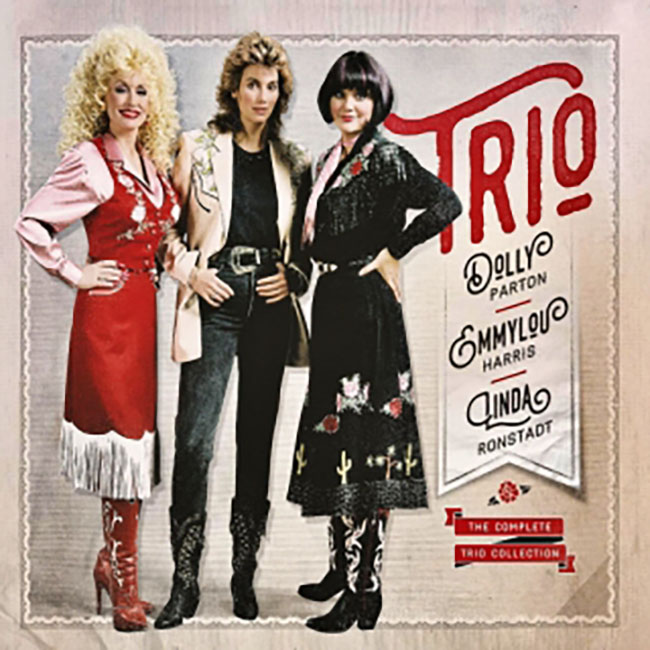
The Complete Trio Collection (Dolly Parton, Emmylou Harris & Linda Ronstadt) After the Gold Rush – A seminal Neil Young rework by these ladies that is so beautifully done, I was left slack-jawed when I first heard it. On the Onkyo, the trio sounded like they were sharing a microphone, but the Nu-Vista spaced them far enough apart that I realized they each had their own individual mics. This spacing appeared often in most Rock, Jazz, and Classical music. It was always consistently better than any other unit I have tested in the past, and the improved sound quality ranged from subtle to obvious, depending on the genre. The goal for an audiophile here is not to have a “like they are playing live in my room” experience, as much as it is to “being there in the venue, sitting in the second or third row” experience. That is what the Nu-Vista 600.2 did for me. It took me off my couch and into the venue itself. It was transcendental.

Maestro: Music by Leonard Bernstein (Original soundtrack) Overture to Candide– From the motion picture starring Bradley Cooper as Lenny, this exciting delivery performed by the London Philharmonic has wonderful dynamic swings and really filled my media room with the big scale that an orchestra in full tilt can deliver. Throughout the entire performance, I could easily hear the triangle, horn, and string sections and timpani in great clarity and detail. Nothing was masked or muddied. The whole orchestra sounded wide open and had plenty of breathing space. All the impact and excitement were fully realized with the Nu-Vista 600.2 being in complete control of the music.
Secrets Sponsor
The Musical Fidelity Nu-Vista 600.2 Integrated Amplifier is an audiophile statement piece that focuses on the analog reproduction of music in its purest essence.
- Excellent full frequency reproduction
- Outstanding imaging and detail
- Tight control over my speakers
- Industrial build quality
- Natural, open sound quality that was beguiling
- Nothing of consequence
The Musical Fidelity Nu-Vista 600.2 is an audiophile-grade piece of equipment that most of us should dream about. As I mentioned, once I listened to this over time, the more I realized what potential I was missing out on. It is not often that a piece comes into my media room and changes my perspective on my listening experience, but the Nu-Vista 600.2 was a rare exception. It is designed to reproduce an analog signal to its fullest potential, and it does this in spades. It is built to last for years (your kids will fight over this one when you are gone) and will provide you with the most exceptional music reproduction you can imagine. It changed my perspective in that the source is just as important, if not more so, than just purchasing good speakers and calling your audio quest finished. Paired with full-range speakers of high caliber, your music experience will be greatly enhanced! Highly recommended!


